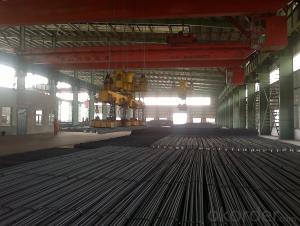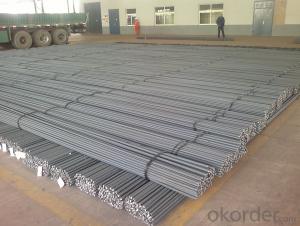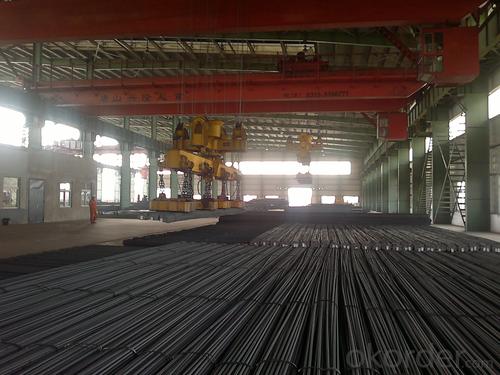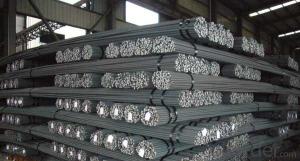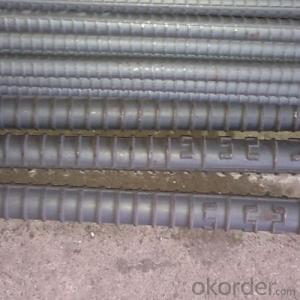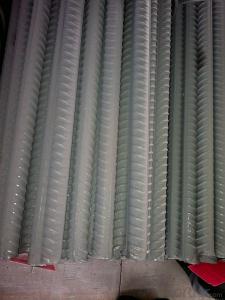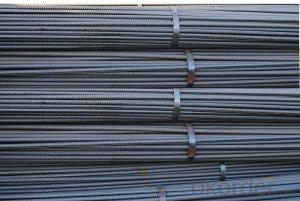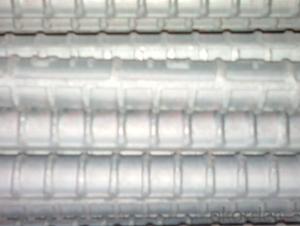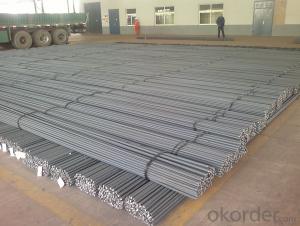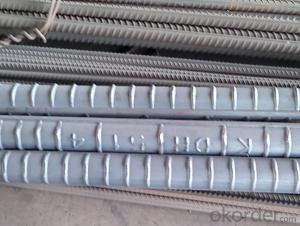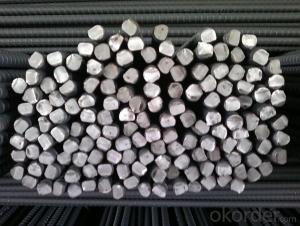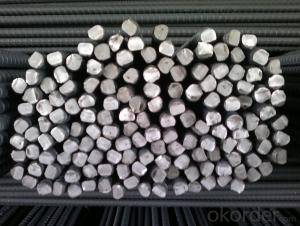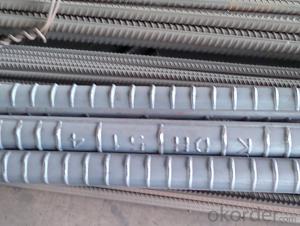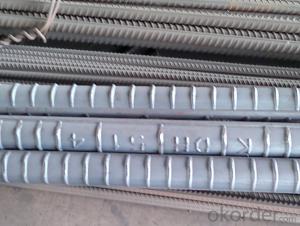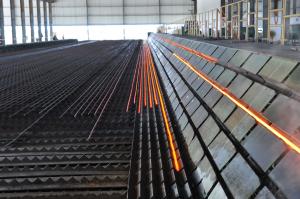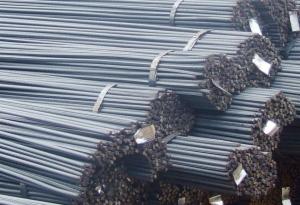Hot Rolled Deformed Steel Rebars ASTM, GB HRB400Cr, HRB500Cr
- Loading Port:
- Shanghai
- Payment Terms:
- TT or LC
- Min Order Qty:
- 100 m.t.
- Supply Capability:
- 200000 m.t./month
OKorder Service Pledge
OKorder Financial Service
You Might Also Like
OKorder is offering Hot Rolled Deformed Steel Rebars ASTM, GB HRB400Cr, HRB500Cr at great prices with worldwide shipping. Our supplier is a world-class manufacturer of steel, with our products utilized the world over. OKorder annually supplies products to African, South American and Asian markets. We provide quotations within 24 hours of receiving an inquiry and guarantee competitive prices.
Product Applications:
Hot Rolled Deformed Steel Rebars ASTM, GB HRB400Cr, HRB500Cr are ideal for structural applications and are widely used in the construction of buildings and bridges, and the manufacturing, petrochemical, and transportation industries.
Product Advantages:
OKorder's Hot Rolled Deformed Steel Rebars ASTM, GB HRB400Cr, HRB500Cr are durable, strong, and wide variety of sizes.
Main Product Features:
· Premium quality
· Prompt delivery & seaworthy packing (30 days after receiving deposit)
· Can be recycled and reused
· Mill test certification
· Professional Service
· Competitive pricing
Product Specifications:
Manufacture: Hot rolled
Grade: HRB400, HRB500 etc
Certificates: ISO, SGS, BV, CIQ
Length: 6m – 12m, as per customer request
Packaging: Export packing, nude packing, bundled
Deformed Steel Bar | ||
Diameter (MM) | Cross Sectional Area (MM2) | Theorectical Weight (KG/M) |
6 | 28.27 | 0.222 |
8 | 50.27 | 0.395 |
10 | 78.54 | 0.617 |
12 | 113.1 | 0.888 |
14 | 153.9 | 1.21 |
16 | 201.1 | 1.58 |
18 | 254.5 | 2 |
20 | 314.2 | 2.47 |
22 | 380.1 | 2.98 |
25 | 490.9 | 3.85 |
28 | 615.8 | 4.83 |
32 | 804.2 | 6.31 |
36 | 1018 | 7.99 |
40 | 1257 | 9.87 |
FAQ:
Q1: Why buy Materials & Equipment from OKorder.com?
A1: All products offered byOKorder.com are carefully selected from China's most reliable manufacturing enterprises. Through its ISO certifications, OKorder.com adheres to the highest standards and a commitment to supply chain safety and customer satisfaction.
Q2: How do we guarantee the quality of our products?
A2: We have established an advanced quality management system which conducts strict quality tests at every step, from raw materials to the final product. At the same time, we provide extensive follow-up service assurances as required.
Q3: How soon can we receive the product after purchase?
A3: Within three days of placing an order, we will arrange production. The normal sizes with the normal grade can be produced within one month. The specific shipping date is dependent upon international and government factors, the delivery to international main port about 45-60days.
Images:
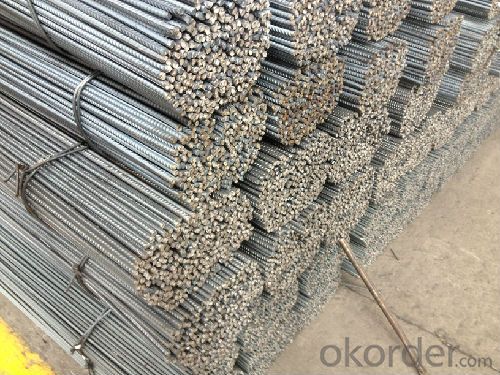
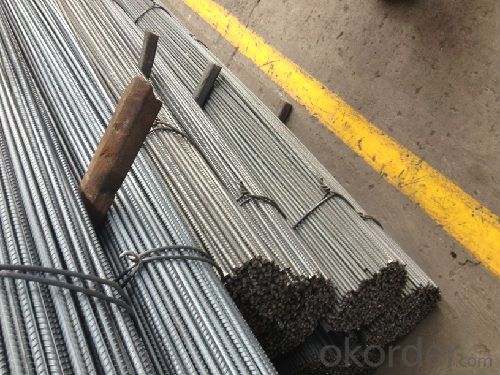
- Q: How do steel rebars affect the overall longevity of a structure?
- The overall longevity and durability of a structure can be greatly improved by the incorporation of steel rebars. These reinforced bars, which are made of high-strength steel, are strategically positioned within concrete structures to provide strength, stability, and resistance against external forces. The primary role of steel rebars is to bear the tensile forces that concrete alone cannot handle. While concrete possesses good compressive strength, it lacks tension strength. By integrating steel rebars into the concrete, the structure becomes considerably stronger and capable of withstanding different loads and stresses. The presence of rebars within a structure ensures that the applied load is evenly distributed throughout, preventing localized cracking or failure. This guarantees that the structure can support its own components as well as external loads like wind, earthquakes, or heavy machinery. Steel rebars also play a crucial part in preventing the formation and propagation of cracks within concrete. When exposed to environmental factors like temperature changes or moisture, concrete tends to expand and contract, resulting in crack development. However, the presence of rebars restricts the movement of the concrete, minimizing crack formation and size. This helps preserve the structural integrity of the building, preventing further deterioration and extending its overall lifespan. Furthermore, steel rebars exhibit high resistance to corrosion, which is a common issue in concrete structures exposed to harsh environments. Corrosion of rebars can lead to rust formation, weakening the steel and compromising the structure's strength. Nonetheless, rebars are typically coated with materials such as epoxy or galvanized coatings, acting as a protective barrier against corrosion. This ensures that the rebars remain in optimal condition, maintaining their strength and contributing to the long-term durability of the structure. In conclusion, steel rebars are vital components for enhancing the overall longevity of a structure. They provide additional strength, distribute loads, prevent cracks, and resist corrosion, significantly improving the structural integrity and durability of concrete structures. This guarantees their ability to withstand various forces and maintain functionality over time.
- Q: Can steel rebars be used in solar power plant construction?
- Yes, steel rebars can be used in solar power plant construction. Steel rebars are commonly used in the construction industry for reinforcing concrete structures, and solar power plants often require the construction of concrete foundations for the installation of solar panels and other equipment. The use of steel rebars helps to provide structural strength and durability to these concrete foundations, ensuring the stability and longevity of the solar power plant infrastructure. Additionally, steel rebars are resistant to corrosion, which is important in solar power plant construction as they are often exposed to various weather conditions. Overall, steel rebars are a suitable material for reinforcing concrete structures in solar power plant construction.
- Q: What is the role of steel rebars in preventing concrete spalling due to fire?
- The role of steel rebars in preventing concrete spalling due to fire is crucial. Spalling is the process where concrete cracks, breaks, or flakes off under extreme heat, such as in a fire. Steel rebars, also known as reinforcement bars, are embedded within the concrete structure to enhance its strength and durability. During a fire, the temperature can rise rapidly, causing the moisture within the concrete to turn into steam. This steam generates pressure within the concrete, leading to spalling. However, the presence of steel rebars helps to mitigate this issue. Steel has a higher melting point than concrete and possesses excellent thermal conductivity. When exposed to high temperatures, the steel rebars conduct and dissipate the heat more efficiently compared to the surrounding concrete. This heat transfer helps to minimize the temperature gradient within the concrete, reducing the risk of spalling. Furthermore, steel rebars act as a reinforcement to hold the concrete together. In the event of spalling, the rebars help to maintain the structural integrity of the concrete by preventing it from completely disintegrating. They provide additional strength and support to the concrete, making it more resistant to cracking and breaking. In summary, steel rebars play a vital role in preventing concrete spalling due to fire. They dissipate heat, minimize temperature gradients, and provide structural support to the concrete. By enhancing the fire resistance of the concrete, steel rebars contribute to the overall safety and longevity of the structure.
- Q: Can steel rebars be used in the construction of hospitals and healthcare facilities?
- Yes, steel rebars can be used in the construction of hospitals and healthcare facilities. Steel rebars provide structural strength and reinforcement to concrete, ensuring the stability and durability of the buildings. They are commonly used in foundations, beams, columns, and other critical structural elements of the construction.
- Q: How are steel rebars stored and transported?
- Steel rebars are typically stored and transported in bundles or coils. They are commonly stored in open yards or warehouses, with proper stacking and support to prevent damage or deformation. During transportation, rebars are loaded onto trucks or flatbed trailers, secured with straps or chains to ensure stability, and transported to construction sites or steel fabrication facilities.
- Q: What are the advantages of using composite steel rebars?
- Using composite steel rebars in construction projects offers numerous benefits. Firstly, they provide superior strength and durability compared to traditional rebars. The combination of steel and a fiber-reinforced polymer (FRP) composite material enhances tensile strength, resulting in a more robust and resilient structure. This is especially advantageous in areas with high seismic activity or extreme weather conditions, where the reinforcement must withstand significant forces. Secondly, composite steel rebars exhibit high resistance to corrosion. Traditional steel rebars are susceptible to corrosion when exposed to moisture and chemicals, causing structural degradation over time. However, the addition of a protective FRP composite layer effectively shields the steel from these corrosive elements, extending the reinforcement's lifespan and reducing the need for frequent maintenance. Furthermore, composite steel rebars offer a lightweight alternative to conventional steel reinforcement. By utilizing FRP composites, the weight of the rebars is significantly reduced while maintaining their structural integrity. This characteristic makes transportation and installation easier, ultimately reducing construction time and costs. Moreover, composite steel rebars possess excellent electrical and thermal insulation properties. Unlike traditional steel rebars, which are conductive, the FRP composite layer acts as an insulator. This minimizes the risk of electrical hazards and prevents the transfer of heat. Such insulation is particularly advantageous in structures that require control over electrical or thermal conductivity, such as power plants or buildings with sensitive equipment. Lastly, composite steel rebars are environmentally friendly. The production of steel rebars typically consumes a significant amount of energy and emits greenhouse gases. However, by utilizing FRP composites, the overall carbon footprint of the reinforcement is reduced, making it a more sustainable choice. In conclusion, the use of composite steel rebars offers enhanced strength, corrosion resistance, lightweight construction, electrical and thermal insulation, and environmental sustainability. These advantages make composite steel rebars a compelling choice for various construction applications.
- Q: Can steel rebars be used in marine structures?
- Yes, steel rebars can be used in marine structures. Steel is a commonly used material in marine construction due to its strength, durability, and resistance to corrosion. However, it is important to use the appropriate type of steel rebars that are specifically designed for marine applications. These rebars are usually made of stainless steel or galvanized steel, which have enhanced corrosion resistance properties compared to regular carbon steel rebars. Additionally, an extra layer of protection such as epoxy coating or cathodic protection systems can be applied to further increase the rebars' resistance to corrosion in harsh marine environments. Regular maintenance and monitoring are also essential to ensure the long-term performance and integrity of steel rebars in marine structures.
- Q: Can steel rebars be used in nuclear power plants?
- Yes, steel rebars can be used in nuclear power plants. Steel rebars are commonly used in construction projects, including nuclear power plants, to reinforce concrete structures. These rebars provide added strength and stability to the concrete, enhancing its ability to withstand various loads and forces. However, it is important to note that the use of steel rebars in nuclear power plants must comply with specific regulations and standards to ensure the safety and integrity of the plant. These regulations may include requirements for the type of steel used, its composition, and mechanical properties. Additionally, the rebars must undergo rigorous quality control measures to ensure they meet the required standards and are free from any defects that could compromise the structural integrity of the plant. Overall, steel rebars can be safely used in nuclear power plants as long as they meet the necessary regulatory requirements and quality control measures.
- Q: Can steel rebars be used in the construction of retaining walls?
- Yes, steel rebars can be used in the construction of retaining walls. They are commonly used to reinforce the concrete structure of retaining walls, providing added strength and stability. The rebars are typically placed horizontally and vertically within the concrete to prevent cracks and withstand the pressure exerted by the retained soil.
- Q: How is steel rebar made?
- Steel rebar is made through a process called "hot rolling," where steel billets are heated and then passed through a series of rollers to shape them into long, straight bars. These bars are then cut into desired lengths and surface treated to enhance their strength and corrosion resistance.
Send your message to us
Hot Rolled Deformed Steel Rebars ASTM, GB HRB400Cr, HRB500Cr
- Loading Port:
- Shanghai
- Payment Terms:
- TT or LC
- Min Order Qty:
- 100 m.t.
- Supply Capability:
- 200000 m.t./month
OKorder Service Pledge
OKorder Financial Service
Similar products
Hot products
Hot Searches
Related keywords
